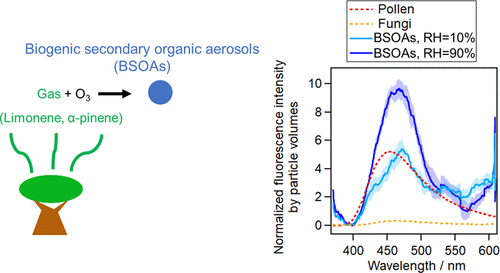当前位置:
X-MOL 学术
›
Environ. Sci. Technol.
›
论文详情
Our official English website, www.x-mol.net, welcomes your
feedback! (Note: you will need to create a separate account there.)
High-Resolution Fluorescence Spectra of Airborne Biogenic Secondary Organic Aerosols: Comparisons to Primary Biological Aerosol Particles and Implications for Single-Particle Measurements
Environmental Science & Technology ( IF 10.8 ) Pub Date : 2021-10-26 , DOI: 10.1021/acs.est.1c02536 Minghui Zhang 1 , Hang Su 1 , Guo Li 1 , Uwe Kuhn 1 , Siyang Li 1 , Thomas Klimach 1 , Thorsten Hoffmann 2 , Pingqing Fu 3 , Ulrich Pöschl 1 , Yafang Cheng 4
Environmental Science & Technology ( IF 10.8 ) Pub Date : 2021-10-26 , DOI: 10.1021/acs.est.1c02536 Minghui Zhang 1 , Hang Su 1 , Guo Li 1 , Uwe Kuhn 1 , Siyang Li 1 , Thomas Klimach 1 , Thorsten Hoffmann 2 , Pingqing Fu 3 , Ulrich Pöschl 1 , Yafang Cheng 4
Affiliation

|
Aqueous extracts of biogenic secondary organic aerosols (BSOAs) have been found to exhibit fluorescence that may interfere with the laser/light-induced fluorescence (LIF) detection of primary biological aerosol particles (PBAPs). In this study, we quantified the interference of BSOAs to PBAPs by directly measuring airborne BSOA particles, rather than aqueous extracts. BSOAs were generated by the reaction of d-limonene (LIM) or α-pinene (PIN) and ozone (O3) with or without ammonia in a chamber under controlled conditions. With an excitation wavelength of 355 nm, BSOAs exhibited peak emissions at 464–475 nm, while fungal spores exhibited peak emissions at 460–483 nm; the fluorescence intensity of BSOAs with diameters of 0.7 μm was in the same order of magnitude as that of fungal spores with diameters of 3 μm. The number fraction of 0.7 μm BSOAs that exhibited fluorescence above the threshold was in the range of 1.9–15.9%, depending on the species of precursors, relative humidity (RH), and ammonia. Similarly, the number fraction of 3 μm fungal spores that exhibited fluorescence above the threshold was 4.9–36.2%, depending on the species of fungal spores. Normalized fluorescence by particle volumes suggests that BSOAs exhibited fluorescence in the same order of magnitude as pollen and 10–100 times higher than that of fungal spores. A comparison with ambient particles suggests that BSOAs caused significant interference to ambient fine particles (15 of 16 ambient fine particle measurements likely detected BSOAs) and the interference was smaller for ambient coarse particles (4 of 16 ambient coarse particle measurements likely detected BSOAs) when using LIF instruments.
中文翻译:

空气中生物二次有机气溶胶的高分辨率荧光光谱:与初级生物气溶胶粒子的比较和单粒子测量的意义
已发现生物源二次有机气溶胶 (BSOA) 的水提取物显示出荧光,可能会干扰初级生物气溶胶颗粒 (PBAP) 的激光/光诱导荧光 (LIF) 检测。在这项研究中,我们通过直接测量空气中的 BSOA 颗粒而不是水提取物来量化 BSOA 对 PBAP 的干扰。BSOAs通过的反应所产生的d -limonene(LIM)或α蒎烯(PIN)和臭氧(O 3) 在受控条件下,腔室中有或没有氨。在 355 nm 的激发波长下,BSOA 在 464-475 nm 处表现出峰值发射,而真菌孢子在 460-483 nm 处表现出峰值发射;直径为 0.7 μm 的 BSOAs 的荧光强度与直径为 3 μm 的真菌孢子的荧光强度处于同一数量级。荧光高于阈值的 0.7 μm BSOA 的数量分数在 1.9-15.9% 的范围内,具体取决于前体的种类、相对湿度 (RH) 和氨。类似地,根据真菌孢子的种类,在阈值以上表现出荧光的 3 μm 真菌孢子的数量分数为 4.9-36.2%。通过粒子体积归一化的荧光表明 BSOA 表现出与花粉相同数量级的荧光,比真菌孢子的荧光高 10-100 倍。与环境颗粒的比较表明,当使用LIF 仪器。
更新日期:2021-12-21
中文翻译:

空气中生物二次有机气溶胶的高分辨率荧光光谱:与初级生物气溶胶粒子的比较和单粒子测量的意义
已发现生物源二次有机气溶胶 (BSOA) 的水提取物显示出荧光,可能会干扰初级生物气溶胶颗粒 (PBAP) 的激光/光诱导荧光 (LIF) 检测。在这项研究中,我们通过直接测量空气中的 BSOA 颗粒而不是水提取物来量化 BSOA 对 PBAP 的干扰。BSOAs通过的反应所产生的d -limonene(LIM)或α蒎烯(PIN)和臭氧(O 3) 在受控条件下,腔室中有或没有氨。在 355 nm 的激发波长下,BSOA 在 464-475 nm 处表现出峰值发射,而真菌孢子在 460-483 nm 处表现出峰值发射;直径为 0.7 μm 的 BSOAs 的荧光强度与直径为 3 μm 的真菌孢子的荧光强度处于同一数量级。荧光高于阈值的 0.7 μm BSOA 的数量分数在 1.9-15.9% 的范围内,具体取决于前体的种类、相对湿度 (RH) 和氨。类似地,根据真菌孢子的种类,在阈值以上表现出荧光的 3 μm 真菌孢子的数量分数为 4.9-36.2%。通过粒子体积归一化的荧光表明 BSOA 表现出与花粉相同数量级的荧光,比真菌孢子的荧光高 10-100 倍。与环境颗粒的比较表明,当使用LIF 仪器。










































 京公网安备 11010802027423号
京公网安备 11010802027423号